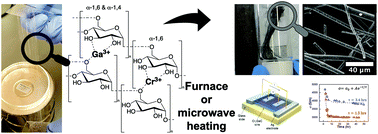The synthesis and electrical transport properties of carbon/Cr2GaC MAX phase composite microwires†
Abstract
While MAX phases offer an exotic combination of ceramic and metallic properties, rendering them a unique class of materials, their applications remain virtually hypothetical. To overcome this shortcoming, a sol–gel based route is introduced that allows access to microwires in the range of tens of micrometers. Thorough structural characterization through XRD, SEM, EDS, and AFM demonstrates a successful synthesis of carbonaceous Cr2GaC wires, and advanced low temperature electronic transport measurements revealed resistivity behavior dominated by amorphous carbon. The tunability of electronic behavior of the obtained microwires is shown by a halide post-synthesis treatment, allowing purposeful engineering of the microwires’ electrical conductivity. Raman studies revealed the polyanionic nature of the intercalated halides and a slow decrease in halide concentration was concluded from time-dependent conductivity measurements. Based on these findings, the process is considered a viable candidate for fabricating chemiresistive halogen gas sensors.



 Please wait while we load your content...
Please wait while we load your content...